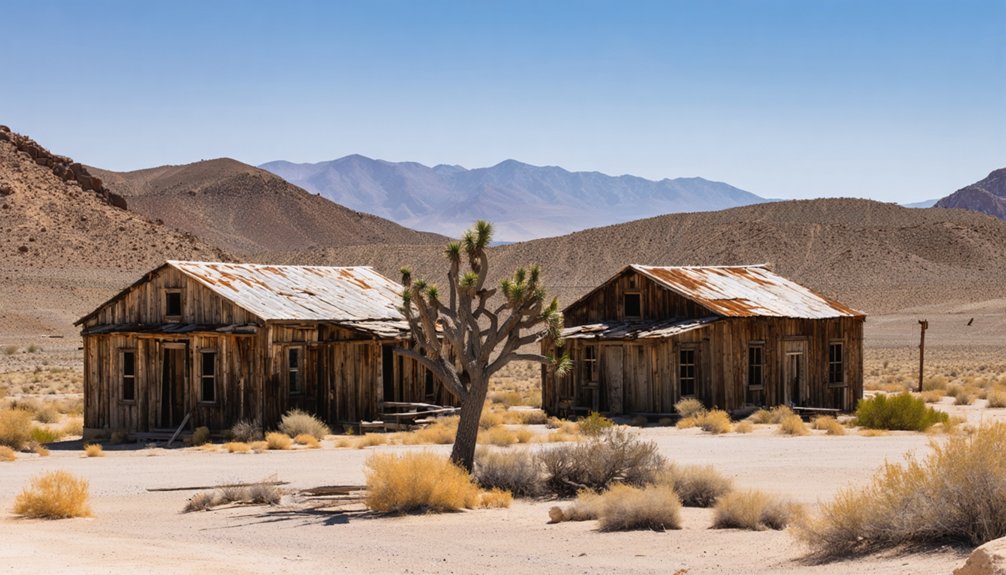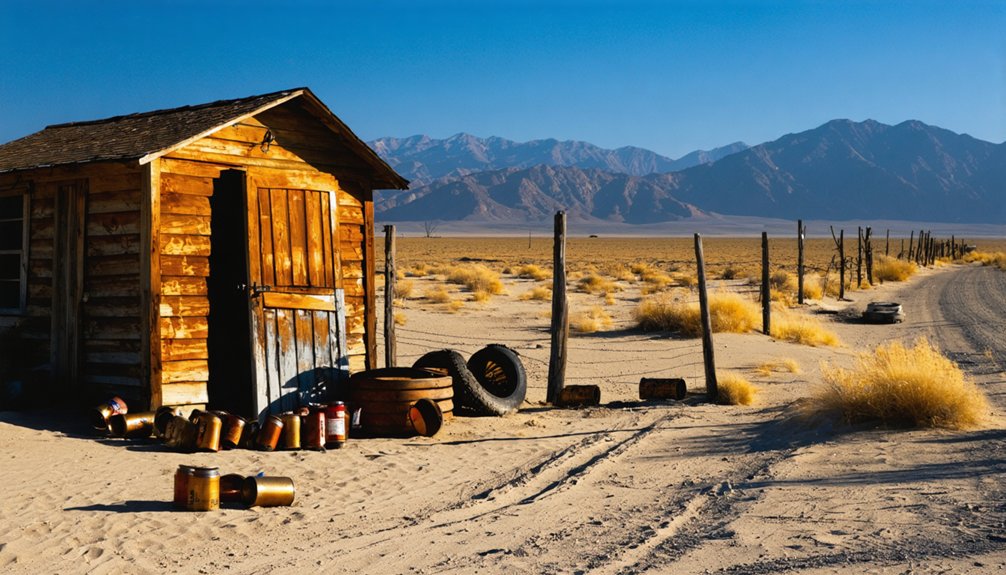Gerstley was a short-lived California ghost town established in 1922 when prospector Johnny Sheridan discovered valuable ulexite deposits. The Pacific Coast Borax Company developed the site, building a three-mile narrow-gauge railroad and employing Milwaukee gasoline locomotives for ore transport. Despite producing 1.25 million tons of borate minerals, operations ceased by 1927, leaving only foundations and debris today. This brief five-year boom exemplifies the ephemeral nature of resource-extraction communities across the American West.
Key Takeaways
- Gerstley was a borate mining settlement established in 1922 that operated for only five years before being abandoned in 1927.
- The site featured a specialized narrow-gauge “baby gauge” railroad that transported ulexite ore across three miles of desert terrain.
- Only foundations, debris, and earthworks remain today, documenting early 20th-century mining technology and socioeconomic stratification.
- The ghost town represents the boom-and-bust cycle typical of California mining communities, distinguished by its focus on borax rather than gold.
- Pacific Coast Borax Company developed the site after acquiring it in 1924, producing over 1.25 million tons of borate minerals during operations.
Discovery and Establishment of the Gerstley Mine (1922)
While the Mojave Desert concealed many mineral treasures throughout its vast expanse, the discovery of the Gerstley Mine in 1922 marked a significant addition to California’s mining heritage.
You’ll find this story begins with Johnny Sheridan, a determined prospector who identified the valuable ulexite deposit in the Resting Spring Range near Shoshone. As part of the broader mineral exploration wave sweeping through Death Valley, Sheridan’s discovery proved financially rewarding when he sold his claim to engineer Clarence Rasor.
Sheridan’s rugged lifestyle reflected the frontier spirit that drove mining exploration in this era—he reportedly shared a cave dwelling with a chuckwalla and skunk near his mineral discovery site. The Pacific Coast Borax company later developed the site extensively due to the commercial value of ulexite deposits found there. In 1924, Rasor transferred ownership to Pacific Coast Borax Company, which began extensive mining operations.
The Brief Golden Era of Borate Mining Operations
The Gerstley Mine experienced a remarkably brief golden era of borate production, spanning just five years between 1922 and 1927, yet yielded over 1.25 million tons of valuable mineral reserves during this condensed operational window.
During its brief five-year heyday, the Gerstley Mine produced an astonishing 1.25 million tons of essential borate minerals.
You’d find Pacific Coast Borax Company investing heavily in infrastructure to capitalize on the rich colemanite and ulexite deposits. They built a narrow-gauge “baby gauge” railroad specifically for transporting ore across the harsh desert terrain. The 3-mile railroad connected the mine to the Tonopah & Tidewater at Gerstley siding located 4 miles north of Shoshone.
Borate mining operations thrived despite logistical challenges, including limited water access and extreme conditions. The company later became known for its popular 20 Mule Team household products, which would gain even greater recognition through television marketing. The minerals extracted became essential for expanding industrial applications in detergents, fiberglass, fire retardants, and ceramics.
This economic boom transformed this remote California region, though inconsistencies in ore purity occasionally complicated production processes. The mine’s impact extended well beyond its short lifespan, influencing corporate consolidation in America’s borate industry.
Transportation Networks and the Baby Gauge Railroad
Constructed in the early 1920s to serve Gerstley’s booming borate operations, Pacific Coast Borax Company‘s innovative narrow-gauge “baby gauge” railroad formed a critical transportation artery spanning three miles between the mine and the Tonopah & Tidewater Railroad.
This marvel of railroad engineering featured a strategic siding at Gerstley with split tracks accommodating ore bins and water delivery infrastructure.
You’ll appreciate how the Milwaukee gasoline locomotive hauled ulexite along this feeder line to the T&T siding, from where it traveled northward to Death Valley Junction for processing—a sophisticated mining logistics solution in harsh desert terrain. The T&T’s connection to Death Valley Junction was vital as it was completed by 1907, allowing efficient transport of minerals from the region’s mines.
Three aspects that revolutionized Gerstley’s operations:
- Elimination of laborious manual ore transport
- Integration of water delivery systems critical for survival
- Creation of a self-contained transportation ecosystem in isolation
After 1926, trucks replaced the dismantled baby gauge, signaling mining’s transient nature.
Milwaukee Locomotives and Mining Equipment Legacy
Powering Gerstley’s mineral extraction operations, Milwaukee gasoline locomotives represented the technological backbone of this remote mining outpost’s transportation infrastructure.
These reliable engines hauled multiple 3-ton ore cars along the 3-mile narrow gauge track connecting to the Tonopah & Tidewater Railroad, demonstrating remarkable locomotive efficiency in harsh desert conditions.
The rugged Milwaukee locomotives conquered desert elements while efficiently hauling tons of mineral wealth across miles of sun-baked narrow gauge track.
Inside the mine itself, you’d find innovative battery-powered locomotives moving ore through tunnels—technology that prioritized safety by eliminating fire risks in confined spaces. The railroad system also included a primitive tank car used to transport vital water supplies to the arid mining site.
One of these battery locomotives survives today at Ryan, preserving this important mining technology heritage.
After Gerstley’s 1927 closure, equipment wasn’t discarded but strategically repurposed—transferred to PCB’s Boron operation or repurposed at Furnace Creek Ranch.
Today, artifacts displayed at the Shoshone Museum offer you glimpses into the industrial ingenuity that briefly transformed this now-ghostly landscape.
Pacific Coast Borax Company’s Industrial Footprint
Pioneering the borax industry since its founding in 1890, Pacific Coast Borax Company (PCB) transformed America’s mineral extraction landscape through strategic consolidation and industrial innovation. Under Francis “Borax” Smith’s leadership, PCB acquired William T. Coleman’s properties, including the Harmony and Amargosa Borax Works, establishing dominance in U.S. borate production.
PCB’s industrial legacy in Gerstley began when they acquired Johnny Sheridan’s discovery in 1924, developing it with:
- A specialized 3-mile “baby gauge” railroad connecting to the Tonopah & Tidewater
- Milwaukee gasoline locomotive technology that revolutionized mineral transport
- Advanced refinement processes creating household staples like 20 Mule Team Borax
The company extracted valuable Ulexite ore deposits from the Gerstley Mine until its closure in October 1927. The iconic 20 Mule Teams became a cultural symbol in American history and marketing success for the company’s products.
As a subsidiary of Borax Consolidated Ltd., PCB’s global reach guaranteed borate products reached international markets despite World War II’s disruptions to their European distribution channels.
The Rapid Decline and Abandonment (1927)
Despite the Pacific Coast Borax Company‘s significant industrial presence, Gerstley’s prosperity proved remarkably short-lived. The mine’s closure in October 1927 came after economic factors converged: depleting ulexite deposits, rising operational costs, and shifting corporate priorities rendered the small-scale operation unprofitable.
You can trace the settlement’s swift demise through the dismantling of its crucial 3-mile narrow gauge railroad—a lifeline that, once removed, severed Gerstley from essential supplies and transportation networks.
The community impact was immediate and absolute. Without employment opportunities, the population rapidly dispersed, leaving buildings to decay in the harsh desert environment. Similar to other ghost towns in San Bernardino County, Gerstley’s remains stand as a testament to the region’s volatile mining history. The town’s fate followed a pattern seen in other sites like Stedman, which was similarly abandoned in the 1930s when its mining operations ceased.
Gerstley’s abandonment wasn’t isolated but reflected a broader pattern of boom-and-bust cycles affecting mining communities throughout California’s deserts—a stark reminder of how quickly prosperity vanishes when resources and infrastructure disappear.
What Remains Today: Archaeological Significance

Although nearly a century has passed since Gerstley’s abandonment, the site’s archaeological significance transcends its minimal physical remnants.
The ghosts of industry whisper through Gerstley’s empty landscape, their significance lying in absence rather than presence.
You’ll find no intact structures—just foundations and scattered debris where a vibrant mining community once thrived. The systematic dismantling in 1927 relocated most physical assets, including the distinctive “baby gauge” railroad infrastructure, to other operations.
Archaeological findings reveal three critical dimensions:
- Industrial Transformation – Subtle earthworks document the evolution of early 20th century mining technology
- Material Culture Patterns – Artifact distribution illuminates socioeconomic stratification within the workforce
- Adaptive Reuse Practices – Evidence of resource recycling demonstrates Depression-era conservation strategies
Historical preservation efforts focus not on grand architecture but on documenting these ephemeral traces before nature reclaims them entirely.
The site’s value lies in what’s missing—a reflection of capitalism’s mobility and resource extraction’s impermanence.
Gerstley’s Place in California’s Mining Ghost Town Heritage
Gerstley stands as a quintessential example within California’s rich tapestry of mining ghost towns, its archaeological traces now serving as historical footnotes rather than prominent landmarks. The site embodies the boom-and-bust pattern characteristic of Death Valley’s extractive enterprises, operating for just five years before Pacific Coast Borax Company redirected its investments elsewhere.
Unlike more celebrated mining settlements, Gerstley’s community life centered entirely around ulexite extraction, with mining labor dynamics shaped by PCB’s corporate structure rather than individual prospecting.
This borate-focused operation, with its innovative “baby gauge” railroad and battery locomotive technology, represents the intersection of industrial ambition and practical adaptation that defined California’s mining frontier.
Today, Gerstley’s brief existence reinforces how specialized operations contributed to the larger narrative of resource extraction that shaped the state’s development.
Comparing Gerstley to Other Death Valley Mining Settlements

When contrasted with other mining sites throughout Death Valley’s storied landscape, Gerstley emerges as distinctively specialized in both purpose and structure. Unlike Rhyolite or Skidoo where gold fever drove rapid development, Gerstley’s identity was singularly defined by borax extraction within a controlled company environment.
These Gerstley comparisons reveal its unique position in the mining industry hierarchy.
- Industrial Isolation – While Ryan and Lila C boasted elaborate tramways and diversified amenities, Gerstley maintained a deliberate simplicity, free from the infrastructure bloat that ultimately doomed its counterparts.
- Economic Autonomy – Gerstley operated outside the volatile gold economy that dictated the fate of Keane Wonder and Chloride City.
- Temporal Distinction – You’ll find Gerstley occupied a pivotal period between early boomtowns and later mechanized operations.
Frequently Asked Questions
Are There Any Accessible Ruins or Structures to Visit Today?
Ever wondered what remains of forgotten settlements? You won’t find accessible ruins at Gerstley today. Unlike sites with historic preservation efforts, this ghost town exploration yields no structures worth visiting in modern times.
Did Any Famous Historical Figures Visit the Gerstley Mine?
No famous historical figures are documented as visitors to Gerstley Mine. Its historical significance stems from mining operations and infrastructure, not from notable personalities who might have explored the site.
What Happened to the Miners After Gerstley’s Closure?
When Gerstley became a ghost town, you’d find the miner’s fate involved dispersal to PCB’s Boron operations, tourism jobs at Furnace Creek, or migration following California’s broader economic opportunities—without documented assistance.
Is Gerstley Located on Public or Private Land?
Ah, bureaucracy’s great triumph—a ghost town whose land status remains unconfirmed! Based on surrounding patterns, you’re likely standing on public land, though mining regulations leave room for private claims. Further research needed.
Were There Any Major Accidents During Gerstley’s Mining Operations?
Historical records show no documented major accidents at Gerstley Mine. You won’t find this operation in mining safety databases or accident reports from its 1922-1927 operational period.
References
- https://vocal.media/horror/bodie-california-the-wild-west-ghost-town-where-the-past-never-dies
- https://www.altaonline.com/dispatches/a62686535/ghost-towns-california-haunted-places-lauren-markham/
- https://www.wilddeathvalley.com/gerstley-mine-shoshone-california/
- https://www.youtube.com/watch?v=2Foz-2R_mH8
- https://tobyskinner.net/2018/02/07/an-american-ghost-town-odyssey/
- https://www.youtube.com/watch?v=ECFaQLcBg-w
- https://dornsife.usc.edu/magazine/echoes-in-the-dust/
- https://en.wikipedia.org/wiki/List_of_ghost_towns_in_California
- https://parks.sbcounty.gov/opinion-beyers-byways-a-brief-history-of-calico-ghost-town/
- https://www.pacificng.com/w/index.php?title=Pacific_Coast_Borax_Company:_Gerstley_Mine_Railroad



